Today, before the summer colors are gone, I went out to take pictures of houses of present and former retired ministers in Stromsburg. Stromsburg has long held an appeal for retired ministers as everyone knows. Here are some of the pictures I got:
Rev. and Mrs. August Johnson, Mission Covenant Pastor and first adminstrators of Covenant Home (thanks to Joyce Lucas for identifying this one).
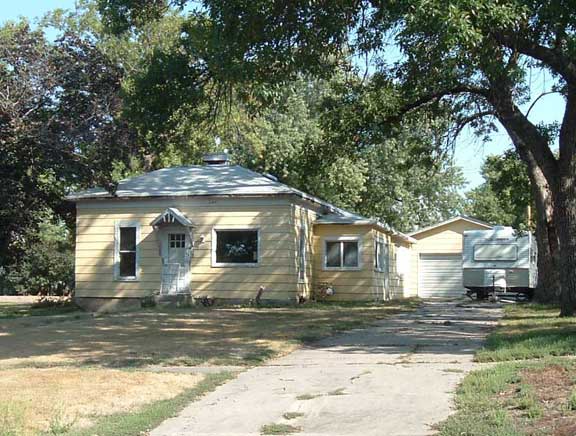
Rev. Loren and Margaret Carlson; remember his tomato crops?

The site of Rev. C.H. Lundgrens, where Calmar and Dorothy Youngquists built their house (Lundgren was a carpenter and prominent early Baptist minister who also preached at the Mission Church and even Swede Home)
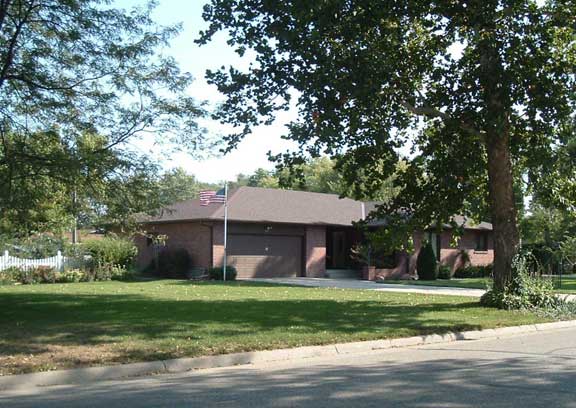
The brick barn on the place where Rev. and Mrs. C. A. Falk lived. They lived in more than one place in Stromsburg and their farm west of town while he served as the first permanent pastor of the Mission Church and engaged in many preaching missions in the region.

Rev. Russ and Barb Ohara's just across 9th street; good friends and fellow-workers at Covenant Home.
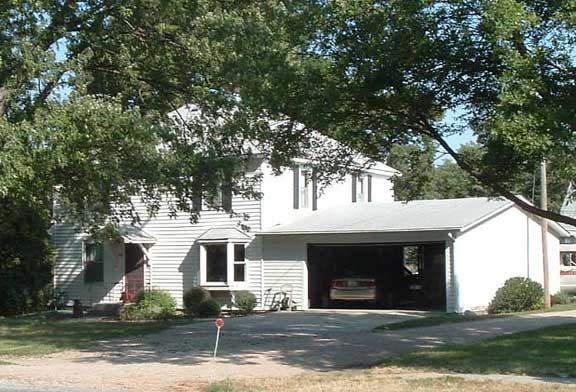
Rev. Lester and Jean Anderson's; here is an opportunity for some newly retired minister as their house is (was) for sale...I tried to convince my friend Chuck Leypoldt to move here.

Rev. Bill and Faith Conrad's; the gazebo he built is still in the back yard.

Rev. John and Jean Esther Dale's on 6th street; I see Dr. John at the library often.

I nearly forgot my neighbors, Dick and Ernie Olson!
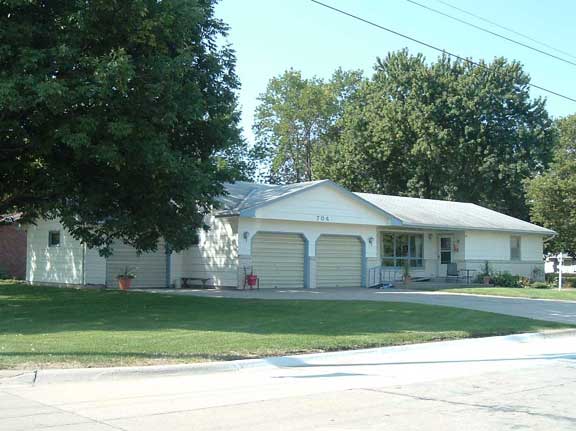
And would you believe, I didn't think of Pastor Bob and Jody Johnson. Guess he hasn't been retired long enough yet for it to sink in.

What is that in the driveway? (A day later I went to take this picture and, lo and behold, drove by Rev. Oscar and Carin Molinder's former house!)

That jarred my memory some more, and sent me to Rev. Earl and Adele Byleen's house, "Ingenting." Swedes give their houses names; that one means "it's nothing." I called our Iowa house "Storlinder" for the 70 foot tree in the backyard...haven't thought of one for the Stromsburg house yet.

The Byleens became residents at one of our favorite places: Park Villa Apartments at Covenant Home. Come to think of it, so did the Martin Lingwalls...another one!
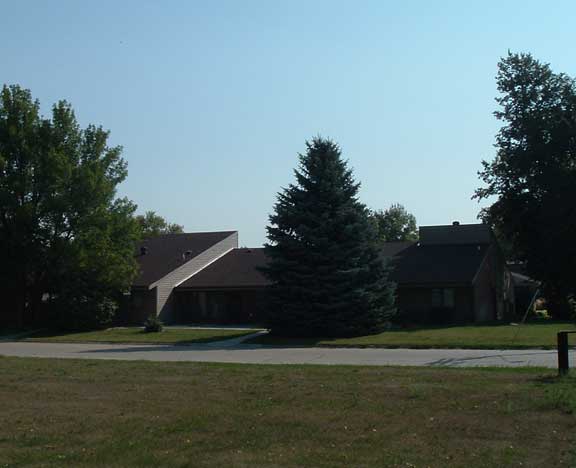
Beside these pictures, there are others. Newspaper reports have Rev. A. N. Sweders building two houses in Stromsburg; this one on the southeast corner of block 9, Nordberg's Addition may be one. If so, the house on the left was son-in-law Finney Peterson's briefly.

Early Mission Pastor L. L. Frisk lived at the corner of 7th and the highway, but that house probably does not remain.
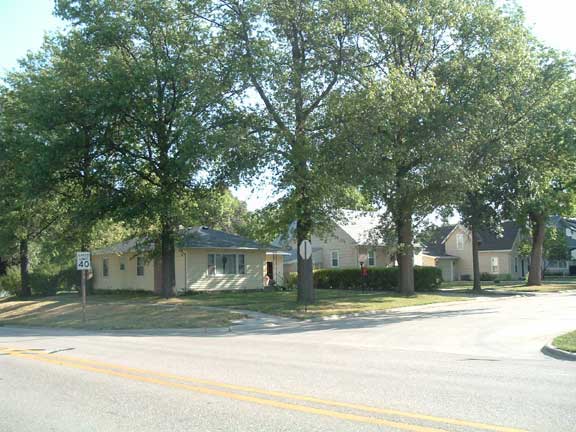
Rev. Olaf Lindh had many Baptist friends in Stromsburg and owned lots in town but I do not know if he lived here.
Rev. O. A. Johnson lived in Stromsburg after serving at Salem and traveled the state for Lutheran missions.
A Swedish Methodist Presiding Elder, Olin Swänson, made Stromsburg his central headquarters for a time, purchasing a house from C. A. Falk in 1888.
Rev. John Quist retired to Stromsburg after having served the Mission Church both here and at Eleanor's home church, Westmark.
Rev. Bill Anderson was still here when we moved to Stromsburg in 1975...thanks to Judy Anderson for identifying where he lived.
She also pointed out that Free Church Conference superintendent Fagerstrom headquartered in Stromsburg, in this house.
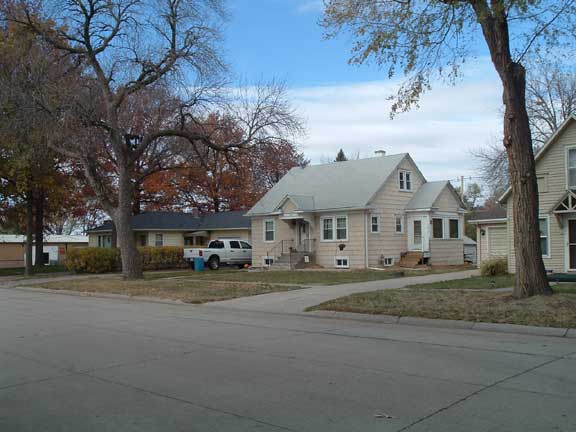
The new housing development is taking shape in Rev. Roger and Wilma Burke's front yard; they used to think they were in the suburbs!
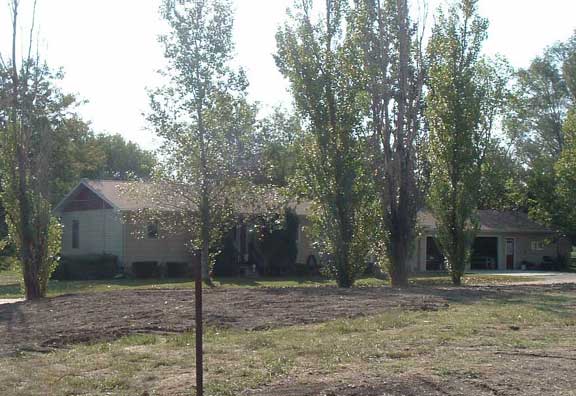
Home, sweet home! Think I'll call it "rödlönn" (red maple).

Does anyone have additions to this list?
-Dalakarl
*********************
Mostly we think of discoveries as something that happen in the future. Here are two examples of discoveries "from the past."
Like many my age, I grew up on a farm. It was five miles from Wausa and near the edge of that community. In other words, some of my country schoolmates went to Wausa High School, some to Creighton. We were near the end of the bus line from each of these towns. It seemed rather remote and generally unremarkable.
Many years later in Walnut, Iowa, we had a librarian who had grown up in Nebraska also at a place called Winnetoon, in the other direction from Creighton. In visiting with her, it turned out that her father owned the farm just across the road east from ours! She said they always called it "the Wausa place." It was always rented out, so I had never heard her family name associated with it. That was almost unbelievable.
Winnetoon had an old Danish Lutheran Church, and she surprised me by saying that the people of this, her church, were very proud that they had continued using the Danish language longer than the Wausa churches continued with Swedish!
Number two: this year was the first time we made it to the Swede Home ice cream social. How we missed it for twenty years living in Stromsburg I don't know, but we don't intend to miss it again. At our table was a local resident who, when hearing I was from Wausa, asked if I knew a certain gentleman from there who was married to his cousin. Not only did I know him, but his son was in my confirmation class! This gentleman had worked as hired man for his cousin's family in the early fifties. He had also worked for a couple of other local farmers, including Nels Landell. Now, Nels Landell owned the farm directly across the road north of ours!
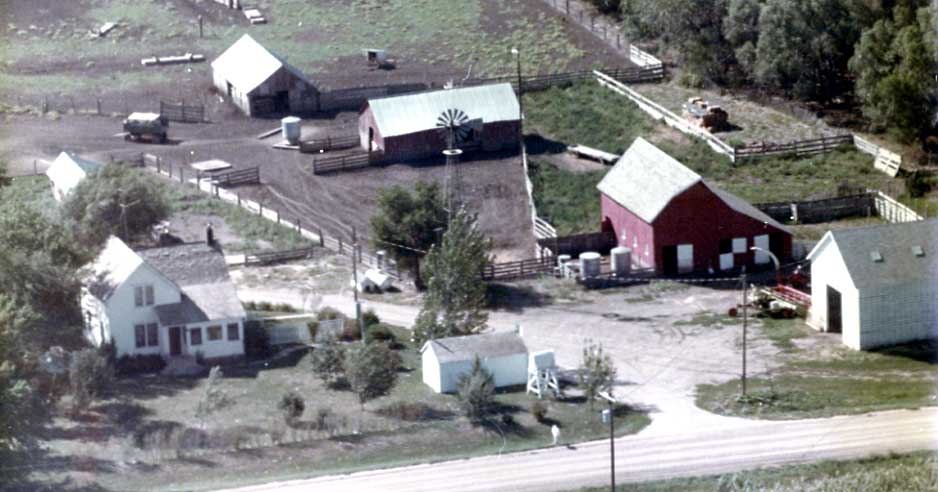
The Old Home Place
After discoveries "from the past" like these, the old place doesn't seem so remote and unremarkable any more.
-Dalakarl
*****************
I have to thank the people that planned the Swedish Festival this year for giving me the opportunity to act as the guide for the trolley tour of Stromsburg Homes and Sites. It was a beautiful day and quite a number took advantage of the chance to get off their feet for a while.
Lots of interesting people made the trip, but the one that sticks in my mind was the Gutz family. As earlier reported, we lived on the edge of the Wausa community, and so were close to some non-Swedish neighbors including many who attended the Golgotha German Lutheran church just about a mile from us. Just how we put together the pieces I have forgotten, but these Gutz people were descended from members of that church.
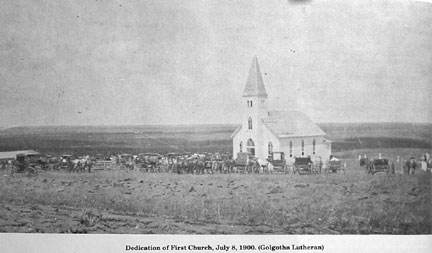
Early View of Golgotha German Lutheran
I even remembered some of the first names of that generation, and vaguely remembered that one of them did custom corn shelling for my dad in the fifties. Corn shelling was quite a production in those days, almost like thrashing. It was very impressive to a young lad to see and hear all the commotion going on out in the farmyard. The Gutz people acknowledged that one of the great uncles did corn shelling.
As they were getting off the trolley, one asked me if I knew Swedish. Giving him a very qualified but somewhat positive answer, he came back with "I've always wondered what Vitame Vas means."

Good Food and Plenty of it
Those readers who have enjoyed a meal at Omaha's Bohemian Cafe know that this is their slogan ("we welcome you")...and not Swedish. I hope that fellow was not too embarrassed; the Gutz folks were good neighbors.
-Dalakarl
********************
Folkets Vän 32
Two Lost Pearls: Found
This is the famous question that became the hallmark of the Swedish Mission Friends, and associated with their founder, P. P. Waldenström. He cited this question when putting forward his view of the atonement, which caused widespread controversy in that day. The watchword became legendary, but did Waldenström invent it?
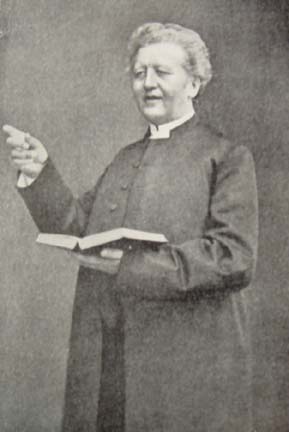
A friend recently entrusted me with a collection of books which included a copy of Luther's Small Catechism in Swedish. This is the little book which our forbears had to memorize in large parts in order to pass their confirmation examination...which was done at a public church service and the anxiety of that experience lived in their memories.
In that book the articles of the Creed are stated, with simple explanations. Following each statement is the following question:
"Var stor det skrivet?"
I was astounded. Waldenström did not invent it. He was using a phrase familiar to every Lutheran confirmand. By the time my generation came around, this was completely forgotten. With the loss of that association, much of the power of the old watchword was also lost. I am glad to have found this lost pearl.
"We believe in the Bible, the Old and New Testament, as the Word of God and the only perfect rule for faith, doctrine and conduct."
When the MissionsForbundet (Mission Covenant) was formed in Chicago in 1885, these words were advanced as its only creedal statement. They have ever since remained a distinctive for Covenanters, and have served well. It was determined to live by these words and forego all "man-made" creeds. Did the Covenant founders invent these words?
A brief digression here, back to a trip to Omaha in which we were looking for old Swedish church buildings. It took two trips to find Salem, in South Omaha, now used for apartments. Just a couple of blocks away was another Lutheran church with a curious inscription on the cornerstone: Lutheran Church U.A.C. It took some enlightenment from a Lutheran friend to decipher this one (Pastor Joel Schroeder, in fact): "Unaltered Augsburg Confession." Older American Lutherans had done some "updating" of this old document, which they held still to be "mainly correct." This did not suit some more recent immigrant Lutherans, who made their watchword the adherance to the "unaltered" version.
Becoming curious, I looked into what was contained in the Augsburg Confession and the "symbolic books." An initial statement was: (are you ready for this?)
"We believe in the Bible, the Old and New Testament, as the Word of God and the only perfect rule for faith, doctrine and conduct."
When the rupture between the Swedish Augustana Lutherans and the Mission Friends occurred, it was a sad day. But the full dimensions of the loss may not have been realized till a couple of generations, and a language change, later. Again, my generation has forgotten that the words we count as our creed are identical, and point significantly, to the old Confessio Augustana. No, the Covenant founders did not invent these words. I am glad to have found this lost pearl, too.
-Dalakarl
*******************
While researching the Valley Swedish Baptist story at the Valley library, her name appeared again as a visiting evangelist. At their centennial services, this church invited a pastor to preach a sermon in Swedish. I was astonished to read his name: Rev. Earl Byleen! Ever since then I've taken special notice when her name pops up. Somewhere along the line it was mentioned that she was based at Swede Bend, Iowa.
Though her fairly common name (there was a Betsy Anderson in Stromsburg, too) is subject to a variety of spellings in the records, it is the fact that she was a Swedish evangelist that secures the identification. She appears in the Swede Bend area census as a resident living with a farm family there; possibly relatives. There was something more special which turned up on a visit to the Swede Bend museum; a book which she had signed herself that we might imagine was distributed on one of her speaking trips. Those trips extended as far as California!
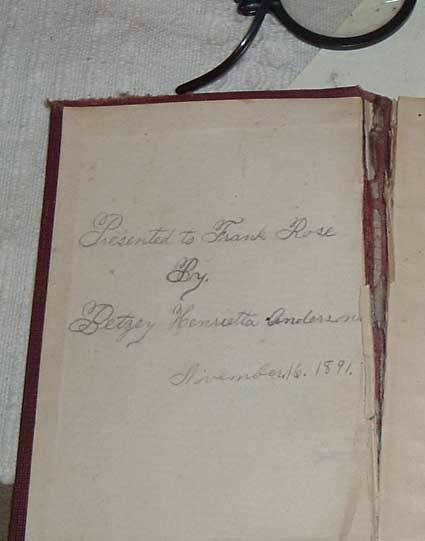
It was from Estina that missionary Fredrik Franson originated. In 1896 he wrote an essay called Prophesying Daughters to outline his Biblical reasons for supporting women in ministry and mission. It seems safe to assume that Betzy Anderson was aware of Franson, and may even have been inspired by him. Long curious about this essay, it was delightful to learn that it had been translated into English in 1976 by North Park Professor of Missions, Rev. Sigurd F. Westburg. As this is being written I am digitizing this document for the Immigrant Church section of Dalakarl.com. I'd be happy to print out a copy for anyone interested. You can read the full text here.
How does this all relate to Stromsburg? Well, according to the current newspaper reports, Miss Betzy Anderson, Swedish Baptist evangelist, visited Stromsburg Swedish Baptist church for a series of meetings in February 1891 (though the reporter here has her as "Bessie" Anderson)! Part of her story, for me, has come full circle.
-Dalakarl
*************************
Lena and Martha
This summer brought us to two places that prompted some wistful memories. First, there was the return of little Lena Davis' tombstone to the Prairie Home cemetery and dedication sponsored by the Polk County Historical Society. That moving event was well covered in the paper and I feel very fortunate to have been able to witness it in person.
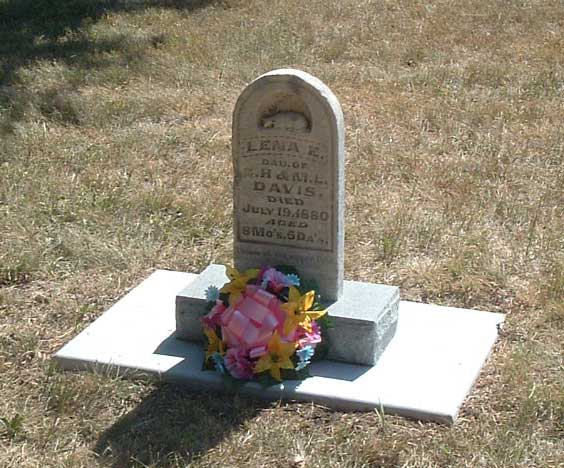
The second discovery, a personal one, was provided by the Stromsburg genealogy group. There it was found that a little girl named Martha Rodine was buried in the Swede Home cemetery. This nearly forgotten relative was the twin sister of Marie (Rodine) Greenwall, both sisters of my grandmother, Edna (Rodine) Greenwall. The sisters, Edna and Marie, married brothers John and David Greenwall.
In reading the early issues of the Headlight, scarcely one can be found that does not have a notice of some infant or child's passing. We have forgotten how pervasive child mortality was in those "good old days." There is no doubt that our memories are selective: we all tend to forget that which is painful and unpleasant.
Growing up in Wausa, I remember grandma speaking of Swede Home. In fact, it was the first time I had ever heard of that place. But she would mention it as the home of Ann Anderson, who had also moved to Wausa. Only now, sixty years later, do I know that she had a four-year-old sister buried there. Grandma spared me that painful memory.
So, perhaps we might revise our way of describing the advances of our modern age. Instead of pointing to the marvels of transportation, of rail, highway, airlines and even space exploration, we should count as most significant the advances of medicine and health care that have made possible the survival of all those infants and children who were lost in generations past.
-Dalakarl
*********************
Frawley's Lake was probably just out of sight of even the top floor of Central Bible Seminary, but no doubt it was well-known to all the early Stromsburg people, judging from the many references to it in the old Headlights. The first note which caught my attention was an event from the Fourth of July celebration of 1891 when two adventurous boys did a tightrope walk on a highwire stretched 4-500 feet across this lake: they were Charles Swanson and Victor Anderson.
In late August, 1896, public notice was made that bathers in Frawley's pond "must be clad." Evidently neighbors were protesting some skinny-dipping going on there. At another time it was noted that Frawley charged an admission fee for swimmers. Fortunate to be Lewis Headstrom's son-in-law, Frawley was involved in a variety of profitable business ventures and even gave prospecting a try that next spring in the "Klondike."
In June of '99, the Knights of Pythias lodge and the Modern Woodmen lodge engaged in a "tug of war" across Frawley's Lake. There were a surprising number of fraternal organizations in the early days. We did not record the winner, presumeably they were the ones that did not get wet. Then, in August, two alligators were reported in the lake. Then, as now, small reptiles were brought back from trips south, and often turned loose. This was the reporter's theory, if in fact there was any truth to the story.
One winter the ice harvest from the lake was jeopardized by someone breaching the dam, possibly deliberately. Though the remaining water escaped, there was still enough ice for cutting. The amounts of ice stored in winter are amazing, if true. Morrills reported cutting 100 tons for the dairy operation.
In 1903 the Collins Carnival came to Stromsburg with its 100 foot high wire act, 100 foot high dive, even a diving dog, Chinese dancers and, no kidding, a "dog and pony show." All on the banks of Frawley's Lake.
Not till Freeman built his house at the west end of 4th street after 1910 did we know where it was. The Headlight reported that his house was at the edge of Frawley's Lake. Wouldn't it be nice if we still had it?
-Dalakarl
**************************

Touring Swedish America is a book by Alan and Jessica Rousselow-Winquist that has a place on the top of my desk. Published in 1995, it is an amazing record of this couple's visits to many centers of Swedish immigration in America. Mention them at Oakland, Lindsborg, Swede Bend or wherever, and locals remember their visit.
On the cover is a picture of the American Swedish Institute mansion in Minneapolis, which was instrumental in inspiring this book. This mansion was built by S. J. Turnblad, publisher of Svenska Americanska Posten, the largest Swedish language newspaper in America.
When Stromsburg's Folkets Vän newspaper ceased publication, its subscription list was sold to a "newspaper in Minneapolis." Very likely this was Turnblad's paper. Opposite the introduction page is a picture of the water tower in Stanton, Iowa, which is painted to look like a Swedish coffee pot. This is in honor of "Mrs. Olson" of the Folger's coffee ads, who was from Stanton.
It was very distressing when my copy of this book turned up missing a few years ago. We had taken it on our trip to Lindsborg (the maps it contains are very helpful in locating area sites), and we feared it was lost along the way. Then, lo and behold, it reappeared having fallen down behind a drawer in the desk! So, with an extra copy, one now has a new home at the Stromsburg Library for our readers to enjoy.
Another resource that I find delightful is at crossnet.se. There you can listen to Sunday Morning services from, say, the Jönköping Covenant church or dozens of others at your fingertips. I have listened to Baptist and Lutheran services, even Pingströrelsen (Pentecostal). What if our grandparents could have done this!
-Dalakarl
*******************
Just when things were quieting down at the (imaginary) Folkets Vän office, there was an EVENT. It was the kind of event that, when you try to go to sleep that night, you just can't. It's going to take more than one column to tell about it, but just to get to the bottom line, the office now contains a shoulder-high stack of original, bound (sort of) editions of the Stromsburg Headlight newspapers going back to 1885! Forty-seven years worth!
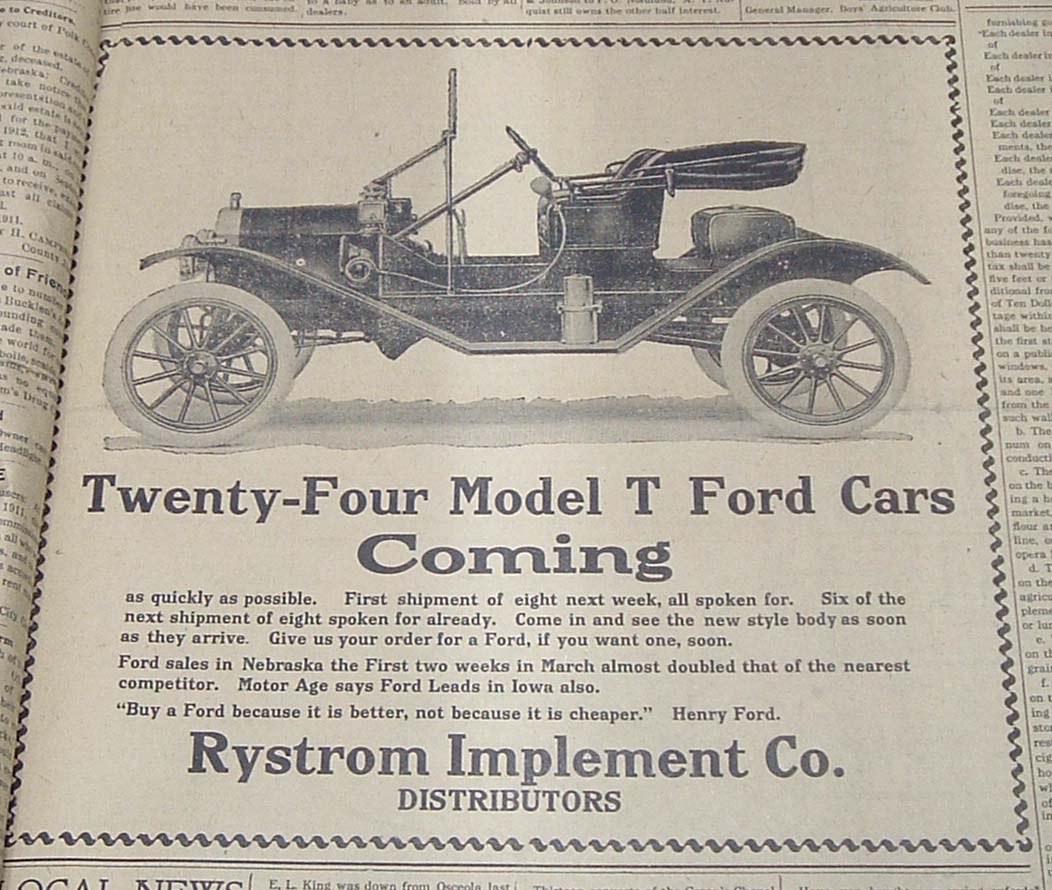
I hope you noticed the word "contains." This event is one link in a chain, and as everyone knows, it takes many links to make a chain work. Without the earlier links this event would be meaningless, and we can now envision which direction the next links will take. Let's do that. What shape will the Nebraska Swedish-American Archive take? Will it be a high-rise tower? Or an underground complex in an old missile silo? O.K., maybe not.
But something is shaping up that rivals and combines the earlier events of written language, the printing press and TV-video, "computerizes" the whole thing and hangs it out there in "cyberspace" where we all can find it on the internet. It's a day that is dawning just now. In all probability, the Nebraska Swedish-American Archive will be...get this...in your pocket! The best part is that "everything old will be new again." But first, let's talk about those old things.
One of the hazards to the survival of old newspapers (and magazines, and books) is that they tend to absorb moisture and get a musty smell. (I know now someone is thinking the same is true of the old men who like to collect them.) Another hazard is that they take up space, and that combination has accounted for the loss of a lot of history. But these papers have cheated extinction, and hopefully are on their way to survival.
The first step in this direction has already been taken at the Stromsburg Library, where all the old Headlights we know of have been filmed and can be read on the microfilm reader. They have all been reduced to the size of a couple of shoeboxes. That is wonderful. No bad smell, either. But the next step will be global, and in your pocket.
-Dalakarl
*******************
I had a feeling the Polk County Historical Society would be good, and it's turning out even better than hoped. It was a little daunting facing the prospects of sorting out all the country churches in Polk County after what it took to figure out just the Stromsburg churches. What a relief to find out that Dianna Langer and her crew had already done the work, and put on a great program at the Lutheran church in Stromsburg recently. They came up with two dozen churches in the towns and two dozen more in the country! The whole story is on picture boards that can be seen at the Museum, but here are some of the highlights.
This will take more than one column, so we'll start in the southwest part of the county. "Three churches within a radius of two miles" is a byline in Mildred Flodman's book, and the one best remembered by most of us was the Swede Plain Swedish Methodist church west of town. That building is preserved on the grounds of Covenant Cedars Bible Camp north of Hordville. Methodists in that part of the country now find their way to either the Stromsburg or Polk Methodist churches. Where the Polk Cemetery is now located, there was an English Methodist Church not quite within that two mile radius known as the Cooper church. It also moved in to Polk along the new railroad extension.
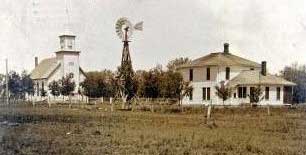
To the northeast was found the Pleasant Home Mission church, on land donated by the Nybergs. When Polk was founded, that congregation (my grandmother Edna Rodine Greenwall's) moved into town and is now the Evangelical Free Church. The third is described by Mildred as "First Baptist" on land given by John Johnson. I wonder if this is not the same as the Bethel Chapel started by Stromsburg Swedish Baptists during the Central Bible Seminary days? The location seems the same. Seminary students were a handy pulpit supply source for regional churches. There was an English Baptist congregation known as LaClede two miles north of Polk where a cemetery remains. That church also moved in to Polk.
Lutheran historian C.F. Sandahl reports: "While pastor in Fridhem (speaking of Rev. O.A. Johnson, Hordville) he carried on mission work in Stromsburg, Central City, and in a settlement half way between Fridhem and Swede Home known as Pleasant Home. The time seemed to be ripe for the organizing of a congregation in this settlement, but it did not materialize on account of Rev. Nordling's (Swede Home) persistent objection." Imagine, there might have been a fourth church in those two miles!
-Dalakarl
*********************
Political maps divide counties and precincts but do not show the effects of some natural lines of division. A classic example of such a natural division are "the bluffs" which mark off the considerable part of the county known as "the valley." Beulah is in "the valley" and surprisingly we may be like many others who seldom venture across that bluff line to the "other side."
Of the Beulah church, Mildred Flodman states: "Records on this church are rather confusing." Apparently there are three locations and two denominations involved in the historical process that culminated in one: the Fairview church which was the longest surviving. There was the Pleasant Valley Methodist group which was several miles to the northeast. In the 1885 plat book this is the only church of the three appearing, though the Beulah cemetery is indicated. This building was moved to Fairview in 1921 and made into a parsonage there.
At the Beulah Cemetery a church was built by the United Brethren and also shared by a Methodist congregation "on alternate Sundays" which may be the reason its name became "the Beulah Christian Church" rather than U.B. or Methodist. This group had been in existence for more than a decade before becoming the Beulah church, evidently meeting in schoolhouses. This building was also moved to the Fairview site in 1929 or 1930 and was used as "Fairview Hall."
Fairview Methodist Church, the last survivor, was built in 1886 and was on circuits with Stromsburg and with Pleasant Valley at various times. Rev. Dudley, whose name appears often in early Headlights, was pastor. As seen above, the other two churches ended up at Fairview. A puzzle exists in the orange Osceola Centennial book, where in the Fairview section it is stated that before the Fairview church was built, that congregation met on the alternating Sundays at Beulah church...
The United Brethren were a German-speaking Protestant group who sought to become part of the Methodist denomination but were for a time denied. Apart from the language difference, they must have been very close in doctrine and practice to the Methodists. At some point the Methodists did allow for a German conference across normal state conference lines, like their Swedish Conference. Soon we will see one of these German Conference Methodist churches just a few miles to the east. Confusing indeed!
-Dalakarl
***********************
Finding the York Swedes: part 2
The quest to find out about early mission churches usually starts with some mention of it in a book and then a trip to its physical location. In the case of the York Mission the process was reversed. There are mentions of a work in York, but they are extremely sparse.
The ELCA church in York traces its origins to a General Synod mission to English speaking Lutherans in 1902. Pastor Harlan Heiers wrote. "Services were begun in the Swedish church at 8th and Platte, but when that church was no longer available, services were discontinued..."
There is a church building at 8th and Platte today, vacant but retaining recent E. Free signage; previously known to belong to the Nazarenes.
From Illustrated History of York: Methodists
"The first quarterly meeting in the town was held by Rev. H. T. Davis, presiding elder of the Lincoln district in April 1872. The meeting was held in the old B. & M. land office. At this meeting steps were taken for the building of the first M. E. Church of York. Its dimensions were to be 24 by 36 feet. The lumber to build the church was hauled from Lincoln on wagons, L. D. Brakeman, being one of those who thus assisted in the construction. The church was located on Seventh Street and Platte Avenue, where the old parsonage now stands...
In 1880 the church building was sold to the Swedish Lutherans and removed to its present site, south west corner of Eighth Street and Platte Avenue."
A chance scanning of the Nazarene section of the York history revealed something interesting. When that congregation purchased the 8th and Platte site, there was an old schoolhouse at the alley being used as a church. They moved it to the back of the lot and built their new building. Next came a drive down the 8th and Platte alley, and sure enough there was a building in the classic missionshuset style! Could it be another survivor?

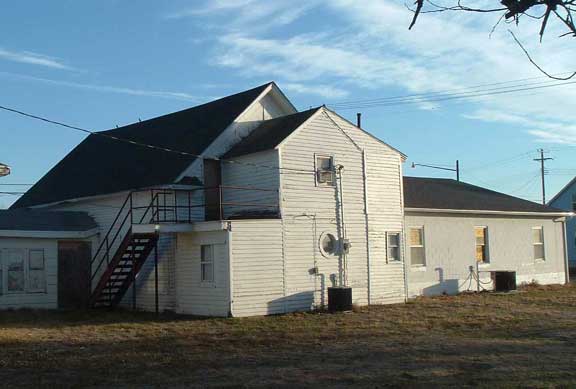
We visited the York museum to find an early picture of the first Methodist church of York. And there it was, on a display board from a Methodist history brochure that appeared to be from midcentury. Very gratifying. But what happened next was even better. A woman who was interested in the same display volunteered that she currently lived in a church building that had been converted into a dwelling. Naturally we were very fascinated by her story, that a church building belonging to the Primitive Baptists had been moved in to York, a wing added, and now was her home. We obtained her address so that we might drive by for a look.

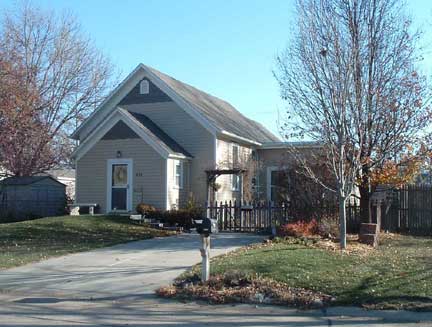
One is never prepared for moments such as this, but seldom has a moment of recognition been more dramatic than the sight before our eyes as we slowly drove by 1816 Platte Ave., York. The building was very familiar. It only remained to open Sandahl's book upon arriving home to confirm that this was exactly like the Bethesda building pictured in the book. Even the "Luther League addition" at the rear of the church remained intact. 1816 Platte is in the north part of York, even northwest. Bethesda lay northwest of York. Evidently the Primitive Baptist had occupied the building in the interim between the Swedish Lutherans, and the lady we were destined to meet in 2012! Since then it has also come to light that Episcopalians, Pentecostals, Adventists and Baptists used the same building for a time. "Old churches never die, they just get recycled!"
-Dalakarl
***********************
Tracing the Polk County Salem Baptist Chapel
Between 1901 and 1906, in the pastorate of Martin Carlson, two chapels were started. One in Osceola and one "8 miles northwest of Stromsburg, known by the name Salem." (Osbeck p.39) Previously meetings had been held in a schoolhouse here, and a future field was anticipated. This did not materialize, and both it and another chapel, Bethel, were put up for sale by Baptist chairman Victor Anderson. But the story of Salem did not stop there for it was still holding midweek meetings "as weather and circumstances permit" in 1912.
Something compelled me to follow the directions "two miles west and seven miles north" just to see if by chance there might be a farmhouse up there that looked like an old church. Within minutes, the second house encountered had that look to it. This is what I wrote that day:
"After tracking this 1876 church building across the street to its Presbyterian site, then back to Baptists again, then out in the country as Salem mission chapel and Sunday School, today the spirit moved me to follow the directions, 2 miles west, 7 north, to its reported location.
Its final fate was to be remodeled into a farmhouse. Scoping out the area, there was a familiar steep-pitched roofline anchoring a very neat and modernized home. The Wheelers told me the story they had heard was that it was a parsonage, moved there from the valley. Close enough! 136 years..Wow!"
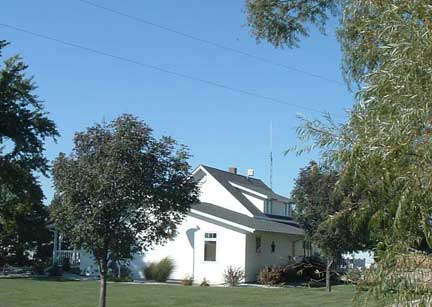
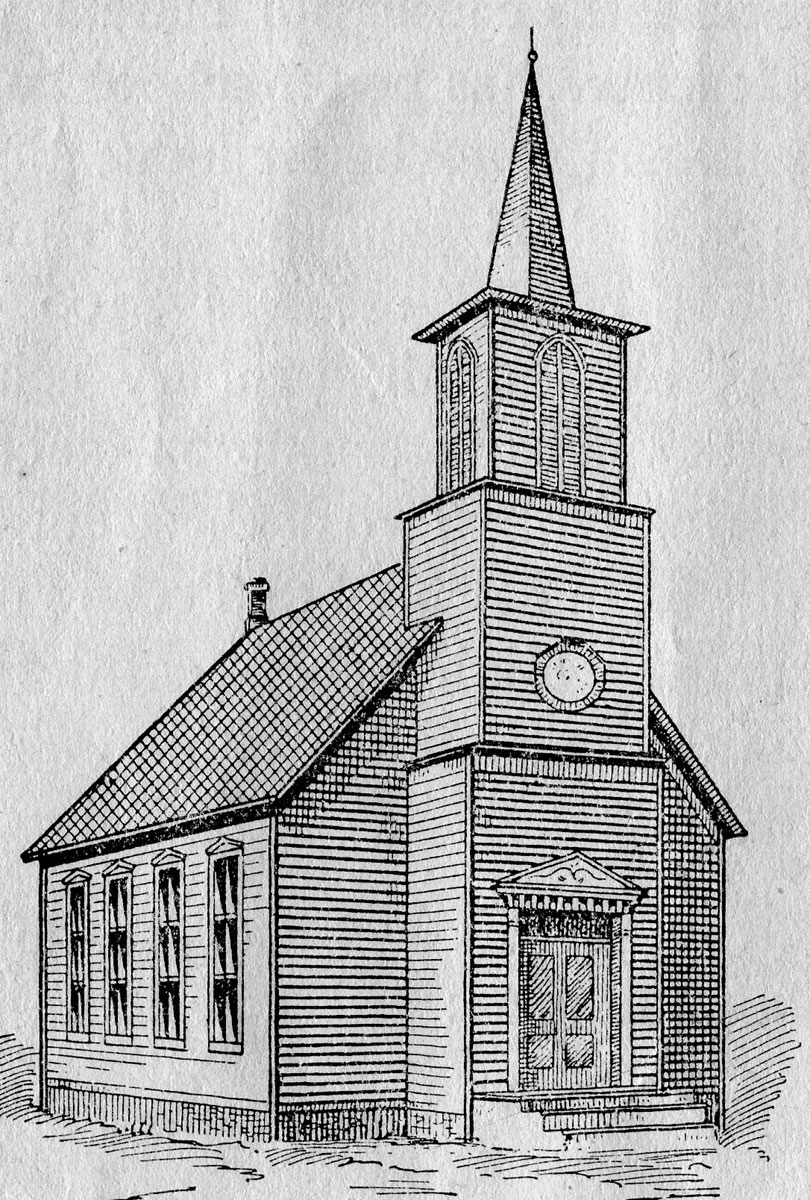
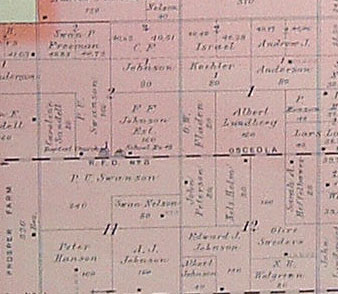
That has been six months ago, and I have been waiting for just that last bit of confirmation that gives one assurance that one is not jumping to conclusions out of wishful thinking, before putting it into print.
Then, in going over documents which have been seen before but not recognized for their significance, that confirmation came. The 1906 Plat Book belonging to my neighbors Jack and Judy Anderson held the answer. I had photographed its pages, but had to go back to confirm without doubt what the photos seemed to show.
There it was, on the Osceola Precinct page, in section 2, right where it stands today as Wheelers' home, it says "Baptist Church." It was not even moved. The 1876 Stromsburg Swedish Baptist Church, their first, with all the twists and turns of its history, survives today in 2012 as the core of the Wheeler home!
-Dalakarl
*************************
"Hord" was the westernmost town; that is the easy one which we now know as Hordville.
Further east is was not so easy. The first announced name for this town was Lucella. The Headlight even had a news section with the heading "Lucella." But the U.S. Post Office had something to say about town names as did the railroad, and for some reason Lucella did not pass muster.
So, the name was changed to "Mohler," a Union Pacific official's name (same is true of Durant, but more on that later). This, too, was submitted to the powers that be, but again the verdict was unfavorable.
Now some impatience was no doubt felt. What was the problem? The August 2nd issue of the Headlight seems to breathe a sigh of relief in the following report: "It has now been at last definitely settled that the name of the town west of Stromsburg is to be Norton, in honor of C.O. Norton, information to that effect having been received from Union Pacific headquarters." Well, too bad, that would have been a nice name but we know better.
Even the elevator siding (Durant) had some problems with naming. The early plat books have it listed as "Haku," which some creative soul had determined to name after a Pawnee Indian word. That would have been very appropriate, too, with this having been Pawnee country and all. But Durant it would be. There was only one house at Durant, and Greenwalls occupied it.
Finally in the August 23 issue, we get the report that proved to be the enduring one. The names are now Polk and Hordville. The editor observed that while the third try is usually the charm, in this case it took four. I remember a trip to visit the Rodine relatives one day, when my dad, who did not have the benefits of a high school education, asked "why would anyone name a town "Poke?"
But through September it fell to the embarassed founders of the "Bank of Lucella" to publish the official changes to their articles of encorporation weekly in the Headlight...now "Bank of Polk." Perhaps they had been too hasty.
In other news, Benedict was originally called "Crownover."
-Dalakarl
*************************
Svenska Psalm-Boken
A good place to begin understanding these books would be the Lutheran book of worship which most of us have seen. It contains not only songs, but readings for times throughout the church year. That continues the format of the old Psalmbooks. Our American songbooks contain only songs, though some newer hymnals have increasing numbers of worship aids included so there may be a trend back in this direction. (the first Swedish Mission hymnals did not even have the music, only the words)
First, we have to get used to the Swedish practice of putting the table of contents (innehål) at the back rather than at the front. Since the book is divided in two major sections, the contents for the first section is about in the middle: page 396 in this one. This is the table of contents for the songs, mostly unfamiliar, but take a look at song #55 which goes like this:
"Var halsad sjöna morgonstund, Som af Profeters helga mun." Do you recognize it? "All hail to thee, O blessed morn! To tidings, long by prophets borne," the Julotta song. Those of us old enough to have heard our immigrant grandparents sing this song on Christmas morning really hate to see it go.
Here is a sampling of items from the table of contents for the second section, found at the very end of the book:
Högtidedagar (holidays observed)
Christi Pinas Historia (Christ's Passion)
Christi Upståndelse (Christ's Resurrection)
Christi Himmelsfärd (Ascension)
Döpelsen (Baptism)
Barndop (Children's Baptism)
Hittebarns dop (Foundlings, or "doorstep baby" Baptism)
Röddop (Emergency Baptism by a layman)
Brudvigseln (Wedding)
Om Barnaqvinnaners Kyrkogång (On a mother's return to church; a purification rite)
huru lif stall jordas (committal service)
Längfredagen ("long Friday", we say "good Friday")
Pingstdagen (Pentecost)
Konungens och Rikets (for the King and Kingdom)
The last page of contents is missing in this one, but there would be the daily prayers, morning and evening, for the home and other things. These books were the property of the worshippers who brought them with every Sunday, used them through the week, and brought them across the Atlantic Ocean in their immigration to America. They would be pleased that we keep them, but even more pleased that we continue in their faith.
It would be interesting to know when these books went out of use. There can be little doubt they still were used in our church when it was the Swedish Evangelical Lutheran Ansgar Synod Church of Stromsburg in the 1870s. We think we have seen changes in church, but they are nothing compared with the changes that were going on at that time. I wonder if the churches in Sweden now project the Psalm-boken on to a video screen?
-Dalakarl
***************************
Some Stromsburg Genealogy
But before proceeding there is a picture emerging which, though disturbing, accounts for the many connections between local families which are showing up in our own relation. It has come to light that not only was grandfather John Greenwall widowed at an early age and remarried, but great-grandfather Charles Rodine was also widowed and remarried and even great-great grandfather Gust Rodine was similarly widowed and remarried. This has resulted in a very large number of "in-laws" right here in Polk County.
The loss of Elisabeth Carlson Greenwall left a vacuum in the Carlson family as well, but this network included first the Forslunds but also the other siblings of Elisabeth such as Alfred Willner and their parents the Carl Johnsons. The remarriage to Edna Rodine Greenwall brought another family into focus, and it is this line which has expanded with the realization that Polk County Rodenes are also part of this Rodine family.
The questions surrounding Hedvig Rodine Gustafson led to learning that her mother, Amanda Fredrickson Rodine had died shortly after her birth. Her father, Charles Rodine was unable to care for her and she grew up in the home of her grandparents, the Charles Fredricksons. This prosperous family name appears on several farms around the Swede Home neighborhood a few miles northwest of Stromsburg.
Charles Rodine then remarries another Amanda, Amanda Gustafson Rodine, a second Gustafson connection. The children of John Gustafson numbered thirteen, and he is one of the founders of the Pleasant Home Mission church which became Polk Mission church. It is yet unknown whether Hedvig's husband Haskel and Amanda are from the same family. A Gustafson farm is in close proximity with the Fredricksons and another family, the Wallers.
Eric Rodene and Kurt Palmberg have confirmed for us that the family of great-great grandfather Gustaf Rodine included two step siblings; Gust Waller and Augusta Waller. Augusta Waller became the second wife of Rev. C. Oscar Palmberg, ancestor of Glenn Palmberg. Gust Waller is the grandfather of two of our friends in Stromsburg; Timm Waller and Willie Waller. The present assumption is that Caroline Waller lost her husband and she remarried the widowed father of Charles Rodine. In other words, Charles Rodine is half-brother to Gust Waller and Augusta "Gussie" Palmberg. In the 1900 census, Gustaf and Caroline Rodine are living with the Wallers; in 1910 with the Oscar Rodines (brother of Charles Rodine.)
In the Fredrickson family there is a wide-ranging network of interrelated families including the McKeags, Austins and ultimately Thomas Record who was one of the first residents of the Stromsburg area. Among their descendants are those we have known in Stromsburg; the Wes and Gordon Fredricksons and their children. In 1908 Charles Fredrickson built a fine home in Stromsburg which we believe is the one known as the Sward house. Our Polk County connections are multiplying.
-Dalakarl
**********************
Fritz Jonson's Wedding
At the Modern Woodmen program some 90 years ago, this song was performed by R. L. Castile poking a bit of fun at the Swedes:
"Fritz Jonson hay got married at Svede Home Saturday, and Oh ve had a yolly time so all das people say,
And all das Svedes for miles around come dressed in all der best, dey all cam down to see Fritz Jonson's vedding.
Der vas lots of Svede fallers, a can't tank how many, but a can tank of a few fallers,
Chorus: Dare vas Frank A. Anderson and Anton Anderson and E. J. Anderson and Swan Anderson, Julare Anderson and Victor Anderson... and da rest of the Andersons var dar too
Das bride she looked so lovely for she ben all dressed in vite, Ve all bane happy at Fritz Jonson's vedding
Da vas lots of odder fallars, let me see, Oh yes,
Chorus: Dare vas Dave E. Peterson and Anton Peterson and Charlie Peterson and Jonny Peterson, Gust A. Peterson and Otto Peterson and Mr. Snus Peterson var dare too.
Oh ve had lots to eat das nite, das supper it bane fine, Vid Knack-a-bro and stock fish too, ve ate most all the time
Vid lingon berries, scorpa, and Kaffee too to bit, Ve have all dose tings at Fritz Jonson's vedding.
Yes, dare vas more fallers as das, a can't tal who da bane but a believe, Oh yes, a know now,
Chorus: Dare vas Pump Jon Carlson and A. C. Carlson and Orley Carlson and Barber Carlson. August Carlson and David Carlson and 'Carlson of Course' he var dare too."
This is a "take-off" on a real song you can hear on You Tube; "John Johnson's Wedding." With local names substituted it must have been a big hit since the Headlight printed it. Oy-oy-oy!
-Dalakarl
***************************
The picture of the old man at the table, hands folded in prayer before his bread and soup, is a familiar one to most of us. Most recently it was seen, appropriately, at Covenant Home. Here is some information about that picture.

It was taken in Minnesota in 1918 by photographer Eric Enstrom, but only gained popularity when his daughter, Rhoda Nyberg "colorized" it with a hand painted tinting process that preceded color photography. She also oversaw its distribution, which must have been very gratifying given its popularity.
Our aunt Albertina also mastered this technique of tinting photographs, and our family has some wonderful examples of her work.
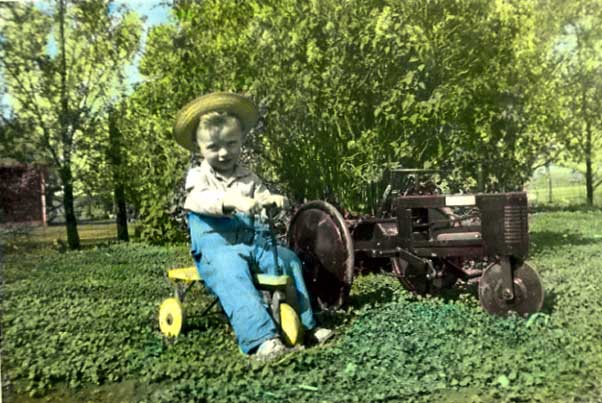
The driver is me, the vehicles made by Uncle Oliver Gustafson
Somewhere along the line, a companion picture was produced with an old woman similarly posed but facing the opposite direction, which made a fine pairing. There can be little doubt given the names above, that this inspiring work came from our Swedish heritage.
The occasion in which this information emerged was the notice of the death of Rhoda Nyberg earlier in 2012. She lived to be 95, and had the singular honor of leaving an iconic image of the simple but profound devotion of our ancestors which we prize so highly.
"I Jesu namn till bords vi går" ( In Jesus name we go to the table ) would be the probable words spoken, and would make a good title for the picture.
-Dalakarl
**********************
The era of the mail-order catalog may be all but a memory now, but it was surprising to learn of its rocky beginnings. At the outset the mail-order houses were deemed a great threat to local merchants, and not very popular with rural mail carriers either, for reasons not hard to imagine. Some of the opponents of mail-order business could be quite creative as seen in the following piece from the Headlight:
"A young man concluded that the home merchant did not advertise a very good line of clothing, so he went to a mail-order house for a suit of clothes. When they arrived, in the pockets of the pants he found the following note: 'Should this fall into the hands of a good-looking young man who disires to correspond with a lady of sweet disposition, kindly address'...etc.
The young man promptly sent a letter to the address and a few days later received this reply: 'Sir -- My wife has received a letter from your address in her maiden name. Twenty years ago, when she worked in a factory she might have written the note. She is now the mother of eleven children and my lawful wife. If you do not quit writing to her I will make your face look like 30 cents worth of hamburger sausage.'
Moral: If you want up-to-date clothes made for 1911 people, with the latest cuts and trimmings and good goods for your money, trade with your home merchants." Though the 1911 Stromsburg stores were still mostly primitive by later standards, it is striking to see very large and elaborate ads in the paper for the likes of Hart, Shaffner and Marx suits or Florsheim shoes. But Sears, Roebuck and Co. could not be held back. And now we have WalMart and Amazon.com!
-Dalakarl
**********************
The story of Noah's Ark is one of the most familiar Bible stories ever. Just last night there was another TV program including a visit to Mt. Ararat where the ark reportedly landed. Gubbe Noah was a song my grandpa used to sing to me; it sounded phonetically like this: "goob-eh Noo-ah, goob-eh Noo-ah, var en heders man." The rest of the verse went like this:
Nar han gick ur arken
plantera' han pa marken
myket vin, ja, mycket vin, ja,
detta gjorde han.
Here is a translation:
Grampa Noah, Grampa Noah
was a worthy guy (repeat)
Stepped out on dry la-and,
grape-vines in his ha-and,
Just to make sure,
Just to make sure,
we did not stay dry!
The little Swedish ditty recalls a part of the Noah story most of our Sunday School teachers omitted: that he was a vintner who relished his product.
Another Noah story comes right out of an old Headlight. It seems there was a man living here known as "Noah", whether that was his real name or a nickname is not revealed. But the house where he lived was predictably called "Noah's Ark" by his good-natured friends. The place made the news when "Noah" decided to expand his single-story "Ark" by adding a second story right on top of the first.
The house was just west of the English Methodist church (that's four houses east of the present Methodist church, 413 E. 5th). You might want to drive by there to see what you think. It looks like it just might be the one! Has (our) Noah's Ark been found?
-Dalakarl
*************************
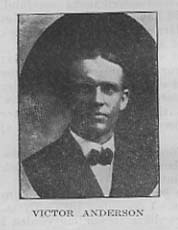
From Osbäck's 1919 history of Nebraska Swedish Baptists
In 1911 Victor Anderson was Mayor of Stromsburg. Something of a "reformer," he set out to clean things up, literally. We could not improve on his colorful style, so here it is in his own words:
Ladies, Gentlemen and—others: It has come to my observation of late that the population of this city is composed of three classes of people; ladies, gentlemen and ———.
We have with us people in this town of intellect and self respect who are assisting in improving and beautifying our city, they are ladies and gentlemen, and I am glad to state that the majority of our people will come under the above heading, but we have also with us a class of ———, well, shall we call them people, who are taking pride in destroying city property, pulling up and tramping down the flowers in the park and breaking off the young trees, also throwing empty beer bottles all over the park, in other words, tearing down what we are trying to build up, and these are certainly not gentlemen and must theretofore come in the third class.
The first complaint that was brought to my notice, after I became your mayor, was that of four-legged hogs, in the northeast part of town, but I am here to say that they have not done one-tenth the damage that these two-legged ones around the square have done, yet the four-legged hogs are not responsible for their deeds as they don't know any better, but in this civilized country, we certainly expect to see some sign of humanity.
In Matthew the eighth chapter we read of how Christ cast out evil spirits and how He suffered them to go away in a herd of swine which afterwards all jumped in the sea and perished, but it looks to me that some of them evidently have succeeded in getting out and now located in Stromsburg, and are trying to root up the park, and all the dirt they are doing is added to the credit of the mayor, for not keeping things in order....
"We have often heard the expression, that the town is dead, and the day after I was elected mayor, one man handed me a comment, by using this language: 'The town is now in the hands of the undertaker.' And since the town was dead before and then turned over to the undertaker we could naturally look for its burial and while it is true that I have buried a good many dead, I have not buried any one alive nor is it my desire to bury any live industry, enterprise or institution of our city which tends to illuminate or brighten the future welfare of our great commonwealth, but I wish to God that we were able to bury, and bury deep, any bad habits, drunkeness, gambling and lowliness in which our young men are indulging. It seems to me that some of them are taking pride in showing the public how much whiskey and beer they dare to ship in to our city although it is supposed to be a dry town.
I can't but look at it as a disgrace to our town and if the money you spent for booze would be used for paying off your honest debts, you would soon be out of debt and own a home of your own and be respected as gentlemen. Those that can not possibly live without the booze can surely stay at home and drink and let respectable people and their property be left in peace. Those who do not feel guilty need not feel hurt. Respectfully, Victor Anderson"
The Mayor and city council proceeded to pass ordinances against numerous offenses which included spitting on the sidewalks, allowing livestock to be loose in the city, public cardplaying etc., but the new city attorney advised that the way in which they were passed made them unenforceable. Isn't that just the way it goes?
-Dalakarl
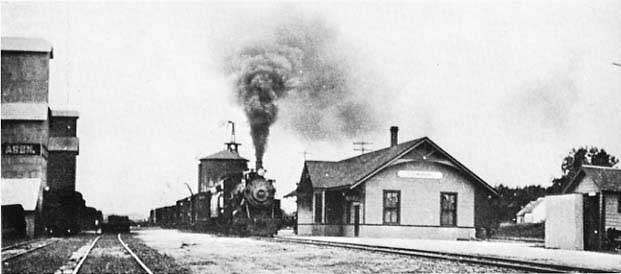
Stromsburg depot with water tower and windmill
By 1912 it was already time to replace the rails on the Stromsburg Branch of the Union Pacific, and that work was just being completed. This would be a good time to fill in some of the railroad news items that have been accumulating.
I'm not sure how long it's been since seeing a "work train" along the U.P. They used to be distinguished by a light green color, and included cars for the workmen to sleep in. There were also cars for servicing ties, tracks, ballast rock etc. When the Stromsburg Branch was extended to Central City, there was a work train here that caused quite a stir. That was because the crew was made up of Japanese men.
This must have caused a lot of curious stares from both sides, and one wonders what those exchanges might have been like between the Japanese trying to buy supplies and the Swedes trying to sell to them. The verdict seemed to be that these visitors from the other side of the world were acceptably polite and well-behaved, something not always attributed to railroad crews.
The depot had finally been moved to the north side of the tracks, but all was not well because in rainy weather travelers still had to negotiate ankle-deep mud getting from downtown to the depot. It's hard to picture the dirt road era. It was not unusual for those taking a car trip to get caught in rain and have to take the train home. About 75 farmers collected a few dollars each from the county in 1912 for dragging the roads past their property.
A few years ago I read about a railfan in South Dakota who had restored a railroad "chapel car." I think it was the Methodists who tried this idea: a passenger car with pews, a pulpit, and even quarters for the preacher. The Headlight reported one appearing in Polk before the churches were built. It was their purpose to go where there were no churches, but Midwest pioneers were not long in building churches everywhere. A clever idea, though. Up in Wausa, the railroad obliged the town's needs by supplying a car fitted out as a jail!
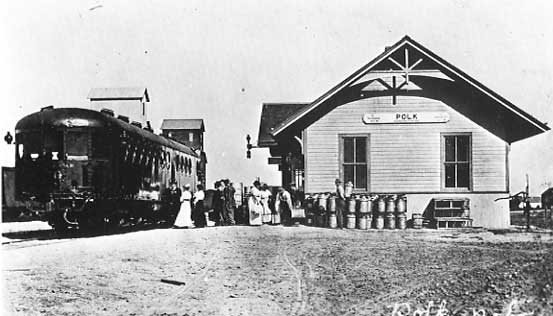
"The Motor" at Polk station
Another innovation in service by 1912 was the "motor," a single self-powered passenger car that made runs both east and west for quick and convenient shopping trips. It was so popular that many were hoping a larger "motor" could be employed. Friends still remember this contraption, locally known as the "tater bug." Having lived in two communities where the railroad was only a fading memory, it is reassuring to hear the rumble and horns of the trains even though only corn gets to ride now.
-Dalakarl
There are just a few key books that unlock the stories of the Swedish Immigrant church and I am very fortunate to have several of them. For Augustana Lutheran, the books by Eric Norelius and much later by Everett Arden stand tall. Swedish Baptists have Adolph Olson and, for Nebraskans especially, C. R. Osbeck. The Covenant story is best told by Karl Olsson and the Free church produced its must-have book at its Golden Jubilee. These remain on the top of my desktop at all times, but when a question about the Swedish Methodists arises there has been nowhere comparable to go. Until now. Liljegren, Westergreen and Wallenius wrote their definitive Svenska Metodismen i Amerika in 1895. The first time I saw a copy was at a ministers' pericope study, brought by Rev. Lester Anderson. Of particular interest was a picture of their Swede Bend, Iowa, church. It reminded me of the first American Covenant church, also at Swede Bend. Rev. Roger Burke was there too, and remarked that the Swedish Baptists had an early church at Swede Bend as well!
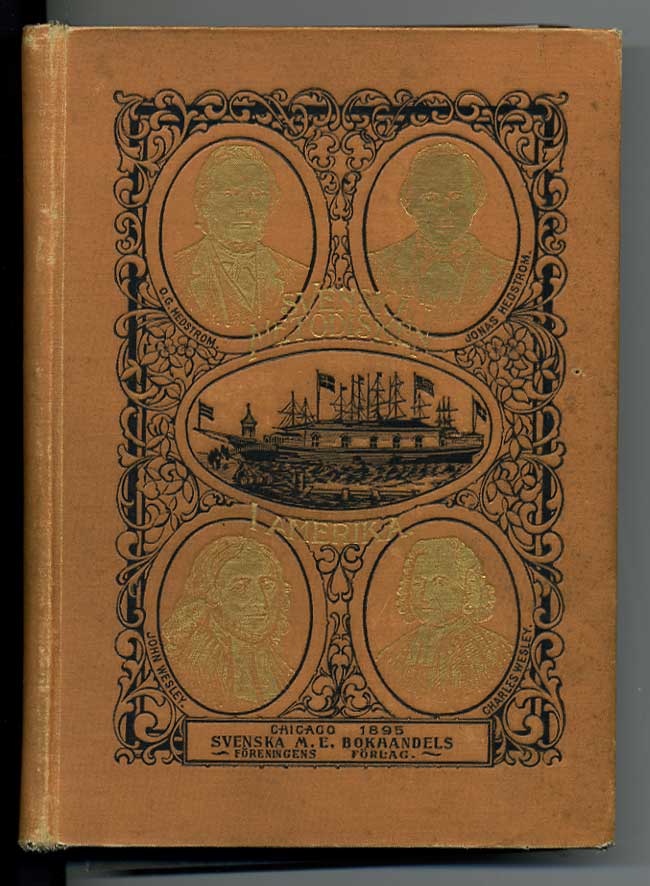
Since that moment my interest in Swede Bend became supercharged. Pastor Joel Schroeder made a photocopy of the picture for me. Later readings revealed that the Baptists and Methodists built churches very near the bend in the Des Moines River named for the Swedes. The Mission (Covenant) group purchased their first church from the Methodists, when that group built their new church....which is still there and operating! So are the Baptists.
I have made special trips to Lincoln's Wesleyan library to find things in that Methodist book, and look for it regularly online. The Wesleyan copy and Lester's are the only two I have seen. North Park also has one, but when there recently I was somewhat overwhelmed by other things. So, that makes three. Just over a year ago when we were looking at houses in Stromsburg, Lester Andersons' was one of those houses. I was surprised to find many of his books still there, and spent the whole time looking through those books, to Eleanor's annoyance. Alas, the Liljegren book was no longer there.
There were a couple of other good ones, but no Methodist history. Until now. Charles and Neeli have been giving a home to three boxes of old books from the Covenant church. Now they have made me very happy by sharing them with me. In this collection...there it was. Number four! In super condition: Svenska Metodismen i America, by Liljegren, Westergreen and Wallenius.
Then, things took a strange turn. Inside the cover was a photocopy, identical to the one Joel made for me decades ago at that meeting at Salem. There is no owners name in the book. How did it come to be in the Covenant church? Can you figure it out? Perhaps I've only seen three copies after all, and this one was Lester's. Joel must have made more than one copy that day! Questions remain.
-Dalakarl
This is the fifty-third column to come out of my computer, and since there are still fifty-two weeks in a year it must mean that a milestone has been passed. It is hard to believe that is possible but it also affords a chance to look back and reflect a bit. First a word of gratitude to the Headlight for giving me such a delightful experience of sharing. Second, thanks to the many dear folks of Stromsburg and Polk County who have given me words of encouragement and added their own contributions to keeping our heritage alive. A very special person said to me recently at the Senior Center, "we now feel like we know you better." I can't tell you how good that made me feel.
What began as a kind of fantasy, reviving the title of Folkets Vän which was a little paper published by the Central Bible Seminary, has gone on to produce some very real results. Cataloging the boxes of Swedish books, Bibles and hymnals that have found their way into my hands reveals another startling number: one hundred thirty plus! They are survivors, like the amazing survivors among the pioneer church buildings we have found.
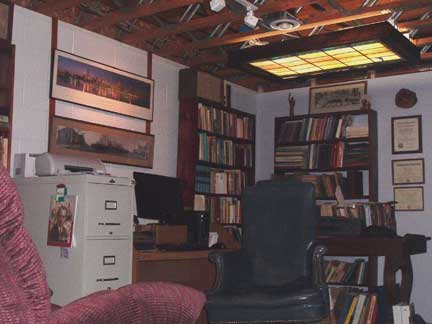
The real Folkets Vän office; my basement
"Your young men will see visions, your old men will dream dreams" says Scripture. I am in the latter category now but am so pleased to know there are young people among us who tell me it is possible that our treasures can continue to survive. Their vision is that books, documents and pictures can be transformed into digital media. That transformation means that instead of boxes of old books, many one-of-a-kind, whole collections can be contained on a CD or DVD disk which can be copied unlimited times for pennies. Now, there's a dream.
It's all in the word "heritage." No one "owns" a heritage any more than any one person owns a collection like this. We are merely caretakers who are privileged to behold them for a time, and then pass them on to future generations. It looks like there will be plenty of material for Folkets Vän for a long while. Thanks!
-Dalakarl